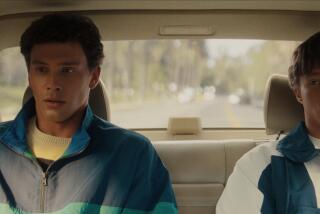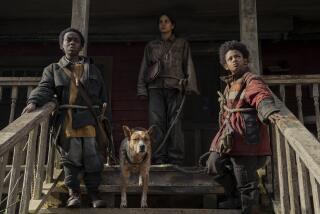Ravishing ‘Eyes’ returns in all its haunting horror
Once seen, never forgotten, “Eyes Without a Face” is a film to haunt your dreams. Disturbing, disorienting, quietly terrifying, it’s one of the least known of the world’s great horror movies and, in its own dark way, a startlingly beautiful and artful piece of cinema as well.
Directed by Georges Franju, “Les Yeux Sans Visage,” to give it its original French title, was first released in 1959, when its pulp subject matter and disturbing imagery led many European critics to cavalierly dismiss it.
In the United States, its fate was even worse: It was dubbed and released under the improbable title of “The Horror Chamber of Dr. Faustus.” Now, in a newly struck and re-subtitled print courtesy of reissue specialists Rialto Pictures, its ravishing virtues are on view at the Nuart Theater as they were intended, just in time for Halloween.
Though this film and 1963’s “Judex” have a small but passionate following, Franju, who died in 1987, remains underappreciated in this country. The co-founder, along with the better-known Henri Langlois of the Cinematheque Francais, Franju worked for years as a director of documentary shorts, including the slaughterhouse-themed “La Sange des Betes,” that earned him the respect of the younger filmmakers of the French New Wave.
“Eyes Without a Face” was only Franju’s second feature, made when he was 47, and, he explained to an interviewer, it was filmed under a series of restrictions. “I was told, ‘No sacrilege because of the Spanish market, no nudes because of the Italian market, no blood because of the French market and no martyrized animals because of the English market.’ And I was supposed to be making a horror film!”
A surrealist who believed with compatriot Jean Cocteau that “the more you touch on mystery, the more important it is to be realistic,” Franju’s ability overcame all obstacles. “What is artificial ages badly and quickly,” he wrote. “Dream, poetry, the unknown must all emerge out of reality itself. The whole of cinema is documentary, even the most poetic. What pleases is what is terrible, gentle and poetic.”
As shot by the great cameraman Eugen Schufftan (who won the Oscar for black and white cinematography for the very different “The Hustler” two years later), “Eyes” is a series of images that burn themselves into your subconscious. Every visual is carefully thought out and brilliantly composed for effect, creating a world that is simultaneously real and surreal. With its ability to go deeply into our fears, this is a motion picture that captures the texture of nightmare as convincingly as it’s ever been done on film.
The idea for “Eyes” was worked on by several writers, including first assistant director and future director Claude Sautet as well as by Thomas Boileau & Pierre Narcejac (whose novels became Clouzot’s “Diabolique” and Hitchcock’s “Vertigo”).
A young woman, her eyes untouched but the rest of her face “a vast open wound,” has disappeared from a clinic where she was taken after a terrible automobile accident. Meanwhile, her father, the celebrated Dr. Genessier (Pierre Brasseur, more impassive and unbending than he was in “Children of Paradise”), lectures on the future possibilities of the heterograft, the transplanting of living tissue from one human being to another.
It turns out that the doctor’s ideas are more than theoretical. Helped by his diabolical assistant Louise (“The Third Man’s” Alida Valli), this brilliant madman has been kidnapping young women in Paris, removing the skin from their faces and attempting a transplant on the visage of his daughter Christiane (Edith Scob), whom he has hidden away in the attic of his chateau. How the relentless doctor (who operates on a pack of constantly howling dogs in his spare time), the devoted Louise and most of all Christiane cope with the effects of his horrific experimentation is the frame this singular film is built on.
Despite its gruesome plot, one of the hallmarks of “Eyes” is the austerity with which it’s made, how little that is blatantly horrific (including Christiane’s face) Shufftan’s discreet black-and-white camera work allows us to see. The reason, Franju explained, is that he envisioned “Eyes” as “an anguish film. It’s a quieter mood than horror ... more internal, more penetrating. It’s horror in homeopathic doses.”
In part because of this delicacy, Franju and Shufftan’s remarkable gift for the visual makes this the spookiest of movies, filled with elegant and poetic images that express longing, terror and despair. Aided by Maurice Jarre’s unsettling music, everything that appears on screen, from the doctor’s shiny black Citroen and Louise’s shinier black raincoat to the bird-like Christiane’s oversize Givenchy housecoats to the film’s final image, one of the most unforgettable ever created, is meticulously calculated to create unease.
The film’s most classic horror scene is an unflinching look at one of the doctor’s blasphemous face-peeling operations. Though in terms of blood and special effects the sequence is pristine, even artificial, by today’s dubious standards, it remains disturbing enough to make the skin crawl far into the night.
Even more psychologically unsettling are the sequences that show Christiane floating around the chateau like a dispossessed ghost, saying things like “My face frightens me, my mask frightens me more.” With good reason. For over her ravaged face Christiane wears one of Franju’s most telling inspirations, a thin plastic mask with holes cut out for her untouched eyes, a neo-Noh object both expressionless and expressive that reinforces the powerful sense of poignancy and loss that is the film’s most impressive achievement.
While most motion pictures have obvious predecessors and successors, “Eyes” stands apart from all others, a film alone. But be warned. Like a nightmare that never ends, this is a vision of madness, loneliness and, yes, horror that, once seen, demands to be viewed over and over again. It is that haunting, and that good.
*
‘Eyes Without a Face’
Where: The Nuart, 11272 Santa Monica Blvd., West L.A.
When: Today through Thursday.
Contact: (310) 281-8223
Running time: 1 hour, 30 minutes
More to Read
Only good movies
Get the Indie Focus newsletter, Mark Olsen's weekly guide to the world of cinema.
You may occasionally receive promotional content from the Los Angeles Times.











